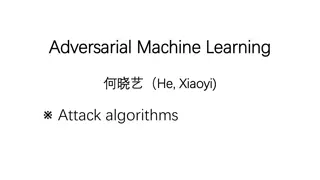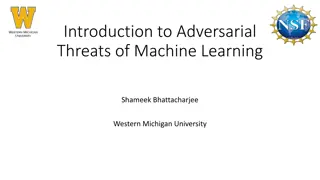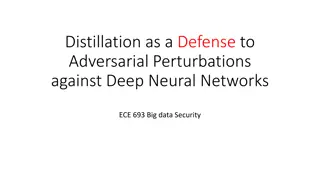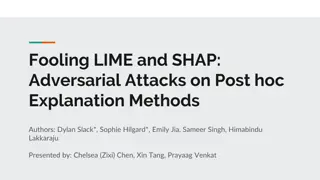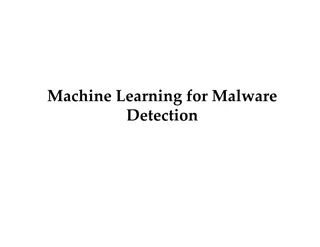Adversarial Machine Learning in Cybersecurity: Challenges and Defenses
Adversarial Machine Learning (AML) plays a crucial role in cybersecurity as security analysts combat continually evolving attack strategies by malicious adversaries. ML models are increasingly utilized to address the complexity of cyber threats, yet they are susceptible to adversarial attacks. Investigating these attacks and corresponding defenses is essential to enhance cybersecurity measures. Examples include spam messages evading ML-based filters and malware bypassing classification systems. Traditional defense methods relied on signatures and heuristics, posing challenges due to their limitations in detecting sophisticated attacks.
Download Presentation

Please find below an Image/Link to download the presentation.
The content on the website is provided AS IS for your information and personal use only. It may not be sold, licensed, or shared on other websites without obtaining consent from the author.If you encounter any issues during the download, it is possible that the publisher has removed the file from their server.
You are allowed to download the files provided on this website for personal or commercial use, subject to the condition that they are used lawfully. All files are the property of their respective owners.
The content on the website is provided AS IS for your information and personal use only. It may not be sold, licensed, or shared on other websites without obtaining consent from the author.
E N D
Presentation Transcript
CS 404/504 CS 404/504 Special Topics: Special Topics: Adversarial Adversarial Machine Learning Machine Learning Dr. Alex Vakanski
CS 404/504, Spring 2023 Lecture 11 Lecture 11 AML in Cybersecurity Part I: Network Intrusion Detection 2
CS 404/504, Spring 2023 Lecture Outline Adversarial Machine Learning in cybersecurity Taxonomy of AML attacks in cybersecurity AML in cybersecurity versus computer vision Network intrusion detection Goals of NIDS Datasets for network intrusion detection Anomaly detection with Machine Learning One-class SVM Autoencoders Variational autoencoders GANs Sequence-to-sequence models Adversarial attacks on ML-based NIDS Feature-level attacks Packet-level attacks 3
CS 404/504, Spring 2023 ML in Cybersecurity Adversarial Machine Learning in Cybersecurity The cybersecurity domain is marked with a perpetual battle between security analysts and adversaries Adversaries continually innovate and adapt their attack approaches, resulting in ever- increasing complexity of cyber attacks Security analysts attempt to quickly respond to new attacks, and try to be one step ahead of cyber adversaries Machine Learning (ML) models have a potential for addressing the complexity of recent attacks, and are increasingly used in cybersecurity Yet, all ML models are vulnerable to adversarial attacks Investigating adversarial attacks and defenses against ML models in cybersecurity applications is crucial for this domain Examples of adversarial ML attacks in cybersecurity: Spam messages designed to avoid ML-based spam filters Ransomware developers evading anti-malware ML-based systems Malware worms evading ML classifiers, and spreading across the network Crypto software evading ML systems, and using resources for mining crypto-currency 4 Rosenberg (2021) AML Attacks and Defense Methods in the Cyber Security Domain
CS 404/504, Spring 2023 Cybersecurity Challenges Adversarial Machine Learning in Cybersecurity Traditional cyber defense relied predominantly on signature-based and heuristic-based methods Signature is a unique set of features that identifies a specific file (e.g., malware) Heuristic is a set of rules developed by security analysis for protection against specific attacks Challenges: both signature- and heuristic-based methods require knowledge about the malicious files, in order to determine the signature or heuristic rules E.g., these approaches have difficulties detecting unknown variants of malware Other challenges in cybersecurity: Traditional defense methods based on manually crafted signatures or heuristic rules are unable to keep pace with recent attacks, which are becoming more complex and sophisticated Organizations are also experiencing a shortage of cybersecurity skills and talent These cybersecurity challenges can be addressed by ML solutions, due to the capacity to handle large volumes of data, and ability to automatically identify signature features or rules for attack identification 5
CS 404/504, Spring 2023 ML Specifics in Cybersecurity Adversarial Machine Learning in Cybersecurity Application of ML in cybersecurity also introduces unique challenges, including: Requirement for large representative datasets for model training o Acquisition of cybersecurity datasets and sample labeling is expensive and time-consuming o Small or imbalanced datasets can lead to poor performance (e.g., missing harmful files, or high false alarms rate) Requirement for interpretability of trained ML models o Current best performing ML models (deep neural nets, SVMs, ensembles) are the least interpretable E.g., it is difficult to understand the parameters importance in a deep NN with millions of parameters Interpretable ML provides transparency to the internal decision-making process by the models, and explains models predictions in human-understandable terms Requirement for low false negatives o Unlike other ML applications, in cybersecurity even a single false negative (i.e., missed malicious file) can have significant consequences o Requires different evaluation approaches, e.g., different metrics to ensure low false negatives Requirement for updating the models continuously o The fast-evolving pace of adversarial attacks requires updated and more capable models o Otherwise, model performance degrades over time 6 Slide credit: Kaspersky Lab (2020) ML Methods for Malware Detection
CS 404/504, Spring 2023 AML in Cybersecurity Adversarial Machine Learning in Cybersecurity Adversarial ML in cybersecurity refers to the setting where an adversary manipulates (perturbs) the input data, in order to exploit specific vulnerabilities of ML algorithms and compromise the security of the targeted system Rosenberg et al. (2021) proposed the following taxonomy of AML attacks in cybersecurity shown in the figure below The taxonomy is based on 7 characteristics of AML attacks that are unique to the cybersecurity domain, listed under 4 categories (threat model, attack type, perturbed features, and attack s output) The taxonomy is explained further on next pages 7 Rosenberg (2021) AML Attacks and Defense Methods in the Cyber Security Domain
CS 404/504, Spring 2023 Taxonomy of AML Attacks in Cybersecurity Adversarial Machine Learning in Cybersecurity A detailed overview of the proposed taxonomy by Rosenberg et al. (2021) 8 Picture from: Rosenberg (2021) AML Attacks and Defense Methods in the Cyber Security Domain
CS 404/504, Spring 2023 Taxonomy of AML Attacks in Cybersecurity Adversarial Machine Learning in Cybersecurity Threat model includes information about: (1) attacker s access to the training set, and (2) attacker s knowledge of the ML model The attacker s training set access can be described as: no access, read data, add new samples, and modify existing samples Based on the attacker s knowledge of the ML model, the attacks can be classified into black-box, white-box, gray-box, and transparent-box attack o Gray-box attack refers to having access to the confidence scores provided by the classifier (i.e., score-based attack) o Transparent-box attack means that the adversary has complete knowledge of the ML model, as well as knowledge about the defense methods used by the model Attacker s goals can include: Confidentiality - acquire private information by querying the ML model o E.g., stealing the classifier s model Integrity - cause the ML system to perform incorrectly for some or all inputs o E.g., causing an ML-based malware classifier to misclassify a malware file as benign Availability - cause the ML system to become unavailable o E.g., generate malicious sessions which resemble regular network traffic, causing the ML system to classify legitimate traffic sessions as malicious, and block legitimate traffic 9
CS 404/504, Spring 2023 Taxonomy of AML Attacks in Cybersecurity Adversarial Machine Learning in Cybersecurity Based on attack s targeting, the attacks are categorized as: Label-indiscriminate attack (non-targeted attack) - minimize the probability of correctly classifying a perturbed sample Label-targeted attack (targeted attack) maximize the probability that a specific class is predicted for the perturbed sample Feature-targeted attack (backdoor trigger attack) input features in the perturbed sample act as triggers for malicious behavior In cybersecurity, ML-based systems often use more than one feature type, and hence, attackers often modify more than a single feature Perturbed features depend on the attacked system, and can include PE header files, PCAP features, words in an email, characters in a URL, etc. Based on the attack s output, the attackscan be divided into: Feature-vector attacks, where output of the attack is a perturbed feature vector (i.e., a perturbed vector of extracted features from a malware file) End-to-end attacks, where the output of the attack is a generated functional sample (e.g., a spam email, runnable PE file, a phishing URL, etc.) 10
CS 404/504, Spring 2023 AML in Cybersecurity vs Computer Vision Adversarial Machine Learning in Cybersecurity vs Computer Vision Most AML research has focused on the computer vision (CV) domain AML in cybersecurity is even more relevant, since there are so many adversaries with specific goals and targets On the other hand, AML in cybersecurity is more challenging Differences between adversarial attacks in CV versus cybersecurity Preserving the functionality of perturbed files o Any adversarially-perturbed executable file in cybersecurity must preserve its malicious functionality after the modification E.g., in CV modifying pixels values does not result in an invalid image Conversely, modifying an API call or arbitrary byte value might cause the modified executable file to perform a different functionality, or even crash Small perturbations generated by gradient-based attacks (FGSM, PGD) are difficult to be directly applied to input features in many cybersecurity applications Input samples (e.g., executables) are more complex than images o Image files typically have a fixed size (e.g., 28 28 pixels MNIST images), and are easily resized, padded, or cropped o Executable files contain different types of input information, and have variable files size (that can range from several KB to several GB) 11
CS 404/504, Spring 2023 AML Applications in Cybersecurity Adversarial Machine Learning in Cybersecurity The main AML applications in cybersecurity are in the following areas: Network intrusion detection Malware detection and classification URL detection Spam filtering Cyber-physical systems Industrial control systems Biometric systems o Face recognition o Speaker verification/recognition o Iris and fingerprint systems 12
CS 404/504, Spring 2023 Network Intrusion Detection Network Intrusion Detection Network security is critical to every organization, as all computer systems suffer from security vulnerabilities Network security requires solutions in place for protection from the increasing number of cyber threats It is essential for every organization to implement some form of intrusion detection systems that can discover potential threat events early and in a reliable manner An intrusion is a deliberate unauthorized attempt, successful or not, to break into, access, manipulate, or misuse some valuable property, which may result into or render the property unreliable or unusable An intrusion detection system (IDS) is a security tool for detecting unauthorized intrusions into computer systems and networks A security system used to secure networks from unauthorized intrusions is a network intrusion detection system (NIDS) NIDS should prevent possible intrusions by continuously monitoring the network traffic, to detect any suspicious behavior that violates the security policies and compromises the network confidentiality, integrity, and availability 13 Slide credit: Ahmad (2020) Network Intrusion Detection System: A Systematic Study of ML and DL Approaches
CS 404/504, Spring 2023 Network Intrusion Detection Network Intrusion Detection NIDS is implemented in the form of a device or software that monitors all traffic passing through a strategic point in the network for malicious activities It is typically deployed at a single point, for example, it can be connected to the network switch (as in the figure) o If malicious behavior is detected, NIDS will generate alerts to the host or network administrators 14 Figure from: Ahmad (2020) Network Intrusion Detection System: A Systematic Study of ML and DL Approaches
CS 404/504, Spring 2023 Goals of NIDS Goals of Network Intrusion Detection Systems The main goals of NIDS include: 1. Detect wide variety of intrusions o Previously known and unknown attacks o Suggests if there is a need to learn/adapt to new attacks 2. Detect intrusions in timely fashion o And minimize the time spent verifying attacks o Depending on the system criticality, it may be required to operate in real-time, especially when the system responds to (and not only monitors) intrusions Problem: analyzing commands may impact the response time of the system 3. Present the analysis in a simple, easy-to-understand format o Ideally as a binary indicator (normal vs malicious activities) o Usually the analysis is more complex than a binary output, and security analysts are required to examine suspected attacks o The user interface is critical, especially when monitoring large systems 4. Is accurate o Minimize false positives, false negatives 15 Slide credit: Intrusion Detection - Chapter 22 in Introduction to Computer Security
CS 404/504, Spring 2023 IDS Categories IDS Categories The figure depicts an IDS taxonomy based on the deployment methods or detection methods Deployment methods o Host-based IDS deployed to monitor the activities of a single host and scan for security policy violations and suspicious activities Requires information processing for each single node in a network o Network-based IDS deployed to monitor the activities of all devices connected to a network 16 Figure from: Ahmad (2020) Network Intrusion Detection System: A Systematic Study of ML and DL Approaches
CS 404/504, Spring 2023 IDS Categories IDS Categories Based on the used detection methods, IDS can be broadly divided into: Signature-based systems o These systems are also known as misuse intrusion detection o The system compares the incoming traffic with a pre-existing database containing signatures of known attacks o Signature databases need to be continuously updated with the most recent attacks o Detecting new attacks, for which a signature does not exist, is difficult Anomaly-based systems o The system uses statistics to form a baseline (normal) usage of the network at different time intervals o Deviations from the baseline usage are considered anomalies o The advantage of these systems is that they can detect unknown attacks o The main challenge is the high false alarms rate (as it is difficult to find the exact boundary between normal and abnormal behavior) 17 Cuelogic Technologies Blog - Evaluation of Machine Learning Algorithms for Intrusion Detection System
CS 404/504, Spring 2023 NIDS with Machine Learning Network Intrusion Detection with Machine Learning Enormous increase in network traffic in recent years and the resulting security threats are posing many challenges for detecting malicious network intrusions To address these challenges, ML and DL-based NIDS have been implemented for detecting network intrusions Anomaly detection has been the main focus of these methods, due to the potential for detecting new types of attacks In the remainder of the lecture, we will first overview the datasets that are commonly used for training and evaluating ML-based NIDS, followed by a description of the ML models used for anomaly detection, and followed by adversarial attacks on ML models for NIDS 18
CS 404/504, Spring 2023 Datasets for Network Intrusion Detection Datasets for Network Intrusion Detection There are several public datasets consisting of records of normal network traffic and network attacks Each record in these datasets represents a network connection data packet The data packets are collected between defined starting and ending times, as data flows to and from a source machine and a target machine under a distinct network communication protocol Network connection data packets are saved as PCAP (Packet Capture) files (i.e., .pcapfile) PCAP files have different formats, e.g., Libpcap (Linux and macOS), WinPcap (Windows), and Npcap (Windows) PCAP files are used for network analysis, monitoring network traffic, and managing security risks o The data packets allow to identify network problems E.g., based on data usage of applications and devices Or, identify where a piece of malware breached the network, by tracking the flow of malicious traffic and other malicious communications 19
CS 404/504, Spring 2023 NSL-KDD Dataset Datasets for Network Intrusion Detection The most popular dataset for benchmarking ML models for NIDS has been the NSL-KDD dataset It is an updated, cleaned-up version of the original KDD Cup 99 dataset (released in 1999) NSL-KDD contains 150 thousand network data from packet records (PCAP files) Each record has 41 features, shown in the table The features include duration of the connection, protocol type, data bytes send from source to destination, number of failed logins, etc. The 41 features are either categorical (4), binary (6), discrete (23), or continuous (10) o Many approaches use a subset of the 41 features Every record has an associated label (indicating whether it is a normal traffic or attack) and a score (the severity of the traffic, on a scale from 0 to 21) 20 Table from: Gerry Saporito A Deeper Dive into the NSL-KDD Data Set
CS 404/504, Spring 2023 NSL-KDD Dataset Datasets for Network Intrusion Detection The attacks in the NSL-KDD dataset are categorized into 4 classes DoS - Denial of Service, by flooding the server with abnormal amount of traffic Probing - Surveillance and other probing attacks to get information from a network U2R (User to Root) - Unauthorized access of a normal user as a super-user (root) R2L (Remote to Local) - Unauthorized access from a remote machine to gain local access The subclasses for each attack are shown below, resulting in 39 attacks 21 Table from: Gerry Saporito A Deeper Dive into the NSL-KDD Data Set
CS 404/504, Spring 2023 NSL-KDD Dataset Datasets for Network Intrusion Detection The records are divided into Train (125 K instances) and Test subsets (25 K instances) As well as a smaller subset Train+20%, containing 20% of the train records (25 K) The number of records per attack class is shown in the table Majority of the records in the Train set are normal traffic (53%) The most common attack in the Train set is DoS (37%), while U2R and R2L occur rarely The Test set contains attack subclasses not seen in the Train set 22 Table from: Gerry Saporito A Deeper Dive into the NSL-KDD Data Set
CS 404/504, Spring 2023 CSE-CIC-IDS2018 Dataset Datasets for Network Intrusion Detection CSE-CIC-IDS2018 dataset was collected with an attacking infrastructure consisting of 50 machines, and a victim infrastructure of 420 machines and 30 servers The testbed includes both Windows and Linux machines It is a collaborative project between the Communications Security Establishment (CSE) and the Canadian Institute for Cybersecurity (CIC) Link to the dataset It is a more recent dataset, in comparison to the most popular KDD Cup 99 dataset The dataset includes the network traffic records (PCAP files) and system logs of each machine, captured with the CICFlowMeter-V3 device The records have 80 network traffic features, which include duration, number of packets, number of bytes, length of packets, etc. There are 7 types of attack (details about the attacks are presented on the next two pages) 23 Table from: https://www.unb.ca/cic/datasets/ids-2018.html
CS 404/504, Spring 2023 CSE-CIC-IDS2018 Dataset Datasets for Network Intrusion Detection Brute-force attack submit many passwords to guess login information Heartbleed attack scan for vulnerable applications (e.g., OpenSSL), and exploit them to retrieve the memory of the web server (can include passwords, credit card numbers, private email or social media messages) Botnet attack - Zeus and Ares malware used for requesting screenshots from infected devices every 7 minutes, and stealing information by keystroke logging DoS attack - Slowloris Denial of Service attack allows a single device to take down the web server of another device, by overwhelming it with network traffic DDoS attack - Low Orbit in Cannon (LOIC) Distributed Denial of Service attack used 4 devices to take down the web server of a target device Web attacks scan a website for vulnerable applications, and conduct SQL injection, command injection, and unrestricted file upload Infiltration of the network from inside attack a vulnerable application (e.g., PDF Reader) is sent via a malicious email attachment, and if exploited, it is followed by IP sweep, full port scan, and service enumerations 24
CS 404/504, Spring 2023 CSE-CIC-IDS2018 Dataset Datasets for Network Intrusion Detection Attacks in the CSE-CIC-IDS2018 dataset 25 Table from: https://www.unb.ca/cic/datasets/ids-2018.html
CS 404/504, Spring 2023 Anomaly Detection with Machine Learning Anomaly Detection with Machine Learning An anomaly is a data point or pattern in data that does not conform to a notion of normal behavior Anomalies are also often referred to as outliers, abnormalities, or deviations Anomaly detection is finding such patterns in data that do not adhere to expected normal behavior, given previous observations Anomaly detection has applications in many other domains besides network intrusion detection, including medical diagnostics, financial fraud protection, manufacturing quality control, marketing and social media analytics, etc. Approach: first model normal behavior, and then exploit it to identify anomalies 26 Blog: Cloudera Fast Forward Deep Learning for Anomaly Detection
CS 404/504, Spring 2023 Anomaly Detection with Machine Learning Anomaly Detection with Machine Learning Anomaly detection can be addressed as: Supervised learning task train a classification model using labeled normal and abnormal samples o E.g., signatures of normal and abnormal samples can be used as features for training a classifier, and at inference, the classifier can be used to flag abnormal samples o This approach assumes access to labeled examples of all types of anomalies that could occur Unsupervised learning task train a model using only unlabeled normal samples, to learn the structure of the normal data o At inference, any sample that is significantly different than the normal behavior is flagged as an anomaly Semi-supervised learning task train a model using many unlabeled samples and a few labeled samples o E.g., train a model in unsupervised way using many samples (presumably most of which are normal), and afterward fine-tune the model by using a small number of labeled normal and abnormal samples 27 Blog: Cloudera Fast Forward Deep Learning for Anomaly Detection
CS 404/504, Spring 2023 Anomaly Detection with Machine Learning Anomaly Detection with Machine Learning Various conventional Machine Learning approaches have been employed for anomaly detection Clustering approaches: k-means clustering, SOM (self-organizing maps), EM (expectation maximization) Nearest neighbor approaches: k-nearest neighbors Classification approaches (One-class SVM) Statistical approaches (HMM, regression models) State-of-the-art results in anomaly detection have been typically reported by Deep Learning approaches Due to the capacity to model complex dependencies in multivariate and high- dimensional data These approaches commonly fall in the following categories: o Autoencoders o Variational autoencoders o GANs o Sequence-to-sequence models 28 Blog: Cloudera Fast Forward Deep Learning for Anomaly Detection
CS 404/504, Spring 2023 One-Class SVM for Anomaly Detection Anomaly Detection with Machine Learning One-class SVM (OCSVM) for anomaly detection is a variant of SVM designed for learning a decision boundary around normal data instances Approach: Train the OCSVM model on normal data (to model normal behavior) At inference, for an input instance calculate the distance to the decision boundary (i.e., the separating hyperplane) If the distance is positive then label the instance as normal data, and if it is negative then label it as abnormal data (anomaly) 1. 2. 3. 29 Blog: Cloudera Fast Forward Deep Learning for Anomaly Detection
CS 404/504, Spring 2023 Autoencoders for Anomaly Detection Anomaly Detection with Machine Learning Autoencoders (AE) An encoder maps inputs into a lower-dimensional representation (code, latent or encoded representation, embedding), and a decoder reconstructs the original inputs Approach: Train the autoencoder on normal data (to model normal behavior) At inference, calculate the reconstruction error: e.g., RMSE deviation between the input instance and the corresponding reconstructed output If the reconstruction error is less than a threshold then label the instance as normal data, if it is greater than the threshold then label it as abnormal data (anomaly) o The manually-selected threshold value allows the user to tune the sensitivity to anomalies 1. 2. 3. 30 Blog: Cloudera Fast Forward Deep Learning for Anomaly Detection
CS 404/504, Spring 2023 Autoencoders for Anomaly Detection Anomaly Detection with Machine Learning Use of autoencoder model for anomaly detection: airspeed during a takeoff The orange line is anomalous speed, the green lines are normal speeds 31 Figure from: Memarzadeh (2020) Unsupervised Anomaly Detection in Flight Data Using Convolutional Variational Auto-Encoder
CS 404/504, Spring 2023 Variational Autoencoders for Anomaly Detection Anomaly Detection with Machine Learning Variational autoencoders (VAE) learn a mapping from input data to a distribution I.e., the encoder network learns the parameters (mean and variance) of a distribution The decoder network learns to reconstruct the original data by sampling from the distribution Typically, a Gaussian distribution is used to model the reconstruction space VAE are trained by minimizing the KL-divergence between the estimated distribution by the model and the distribution of the real data VAE are also generative models, since they can generate new instances (by sampling from the latent code and reconstructing the sampled data) 32 Blog: Cloudera Fast Forward Deep Learning for Anomaly Detection
CS 404/504, Spring 2023 Variational Autoencoders for Anomaly Detection Anomaly Detection with Machine Learning Approach 1 (similar to the AE approach): Train the VAE model on normal data instances (to model normal behavior) At inference, calculate the reconstruction error: e.g., RMSE deviation between the input instance and the reconstructed output of the corresponding sample code If the reconstruction error is less than a threshold then label the instance as normal data, if it is greater than the threshold then label it as abnormal data (anomaly) Approach 2: Train the VAE model on normal data instances (to model normal behavior) At inference, calculate the mean and variance from the decoder, and calculate the probability that a new instance belongs to the distribution If the data instance lies in a low- density region (i.e., below some threshold), it is labeled as abnormal data (anomaly) 1. 2. 3. 1. 2. 3. 33 Blog: Cloudera Fast Forward Deep Learning for Anomaly Detection
CS 404/504, Spring 2023 GANs for Anomaly Detection Anomaly Detection with Machine Learning Several works used GANs for learning the distribution of normal samles The architecture called BiGAN (Bidirectional GAN) is commonly used for anomaly detection E.g., Akcay et al. (2018) GANomaly: Semi-Supervised Anomaly Detection via Adversarial Training (link) In BiGAN: A Generator takes as inputs random noise vectors ?, and generate synthetic samples ? An additional Encoder is added that learns the reverse mapping how to generate a fixed noise vector ? given a real sample ? The Discriminator takes as inputs both real samples ? and synthetic samples ?, as well as latent noise vectors ? (from the Generator) and ? (from the Encoder) 34 Blog: Cloudera Fast Forward Deep Learning for Anomaly Detection
CS 404/504, Spring 2023 GANs for Anomaly Detection Anomaly Detection with Machine Learning Approach: Train the BiGAN model on normal data instances (to model normal behavior) At inference, for a real data instance ?, from the Encoder obtain a latent vector ? The noise vector is ? is fed to the Generator to yield a synthetic sample ? Calculate the reconstruction error: e.g., RMSE deviation between the real data instance ? and the corresponding synthetic sample ? Calculate the loss of the Discriminator, i.e., cross-entropy of predictions for ? and ? Calculate an anomaly score as a weighted sum of the reconstruction error and the loss of the Discriminator If the anomaly score is less than a threshold then label the instance as normal data, if it is greater than the threshold then label it as abnormal data (anomaly) 1. 2. 3. 4. 5. 6. 7. 35 Blog: Cloudera Fast Forward Deep Learning for Anomaly Detection
CS 404/504, Spring 2023 Sequence-to-sequence Models for Anomaly Detection Anomaly Detection with Machine Learning Sequence-to-sequence models aredesigned to learn mappings between sequential data (e.g., time-series signals) Sequence-to-sequence models typically consist of an Encoder that generates a hidden representation of the input tokens, and a Decoder that takes in the encoder representation and sequentially generates a set of output tokens The encoder and decoder are typically composed of recurrent layers, such as RNN, LSTM, or GRU Recurrent networks are particularly suitable for modeling temporal relationships within input data tokens The anomaly detection approach is similar to the Autoencoder models 36 Blog: Cloudera Fast Forward Deep Learning for Anomaly Detection
CS 404/504, Spring 2023 Anomaly Detection with Machine Learning Anomaly Detection with Machine Learning The table lists the pros and cons of the described ML approaches for anomaly detection 37 Blog: Cloudera Fast Forward Deep Learning for Anomaly Detection
CS 404/504, Spring 2023 Benchmarking Models for Anomaly Detection Anomaly Detection with Machine Learning Performance by the presented models evaluated using the NSL-KDD dataset The best performance was achieved by BiGAN and Autoencoder 38 Blog: Cloudera Fast Forward Deep Learning for Anomaly Detection
CS 404/504, Spring 2023 Considerations for Anomaly Detection Anomaly Detection with Machine Learning Imbalanced datasets Normal data samples are more readily available than abnormal samples Consequently, the model may perform poorly on abnormal samples Remedy: collect more data, or consider using precision, recall, F1 metrics Definition of anomaly The boundary between normal and anomalous behavior can evolve over time It may require retraining the models to adopt to the changes in the data distribution False alarms Many of the found anomalies could correspond to noise in the data False alarms require human review of the cases, which increases the costs Computational complexity Anomaly detection can require low latency (DL models are computationally intensive) This may impose a trade-off between performance and accuracy 39 Blog: Cloudera Fast Forward Deep Learning for Anomaly Detection
CS 404/504, Spring 2023 Adversarial Attacks on NIDS Adversarial Attacks on NIDS Feature-level (feature vector) attacks on ML-based NIDS Feature-level attacks are achieved by perturbing a vector of extracted features from PCAP files: the generated adversarial samples are feature vectors Although such adversarial attacks can be successful in evading ML models trained on datasets of extracted features, these attacks are less useful in practice o Since the inputs to the ML model for network intrusion detection are PCAP files o Also, typically it is not known what type of features were used by the ML model Packet-level (end-to-end) attacks on ML-based NIDS Packet-level attacks generate full PCAP files, rather than network features o In the taxonomy by Rosenberg et al. (2021), these attacks are end-to-end attacks based on the attack s output Such attacks are more practical, because the generated adversarial samples can be used to directly evade ML models for network intrusion detection Limitation of current packet-level methods: most attacks focus on evaluating the ability to evade ML models used for network intrusion detection o Less attention is paid to evaluating the functionality of adversarial samples (i.e., whether a perturbed benign sample has preserved its functionality and its malicious behavior) 40
CS 404/504, Spring 2023 Feature-level Adversarial Attacks on NIDS Feature-level Adversarial Attacks on ML-based NIDS Warzinsky et al. (2018) Intrusion Detection Systems Vulnerability on Adversarial Examples (link) White-box evasion attack against a three-layer MLP classifier using the NSL-KDD dataset FGSM (Fast Gradient Sign Method) was used to create perturbed samples by modifying input features o The adversarial samples were misclassified as normal samples by the MLP model The outputs of the attack are modified feature vectors Clements et al. (2019) Rallying Adversarial Techniques against Deep Learning for Network Security (link) White-box evasion attack against Kitsune a NIDS comprising an ensemble of autoencoders o An anomaly score is calculated based on a weighted RMSE deviation of the ensemble of autoencoders The authors implemented 4 attacks: FGSM, JSMA (Jacobian-based Saliency Map Attack), Carlini & Wagner, and ENM (Elastic Net Method) attack o It has the same limitation, as only the feature vectors were perturbed 41
CS 404/504, Spring 2023 Feature-level Adversarial Attacks on NIDS Feature-level Adversarial Attacks on ML-based NIDS Huang et al. (2019) Adversarial Attacks on SDN-Based Deep Learning IDS System (link) White-box evasion attack on port scanning NIDS classifiers in a software-defined network (SDN) o SDNs use software-based controllers to control network traffic (instead of using dedicated hardware-based devices, such as routers or switches) Attacked are three NIDS deep learning models, employing LSTM, CNN, and MLP architectures FGSM and JSMA attacks were performed on regular traffic packets to generate adversarial samples Besides the evasion attack, this work also demonstrated an availability attack o JSMA was applied on regular traffic data packets, which were classified by the port scanning NIDS as attacks, resulting in blocked legitimate traffic 42 Rosenberg (2021) AML Attacks and Defense Methods in the Cyber Security Domain
CS 404/504, Spring 2023 GANs for Adversarial Attacks on NIDS Feature-level Adversarial Attacks on ML-based NIDS Lin et al. (2018) Generative Adversarial Networks for Attack Generation against Intrusion Detection (link) Against seven traditional ML-based NIDS: SVM, na ve Bayes, MLP, logistic regression, decision tree, random forest, and k-NN classifier A GAN architecture called IDS-GAN (GAN attacks against Intrusion Detection Systems) is proposed NSL-KDD dataset was used for training the classifiers, and for evaluating the adversarial samples (with perturbed feature vectors) Yang et al. (2018) Adversarial Examples Against the Deep Learning Based Network Intrusion Detection Systems (link) Against a deep NN model using the same features from the NSL-KDD dataset as in Lin et al. (2018) C&W, ZOO (Zeroth Order Optimization), and a GAN-based attack were used to add small perturbations to the input feature vectors, so as to deceive the deep NN model and misclassify malicious network packets as benign 43 Rosenberg (2021) AML Attacks and Defense Methods in the Cyber Security Domain
CS 404/504, Spring 2023 Packet-level Adversarial Attacks on NIDS Packet-level Adversarial Attacks on ML-based NIDS Homoliak (2019) Improving Network Intrusion Detection Classifiers by Non- payload-based Exploit-independent Obfuscations: An adversarial approach (link) Packet-level attacks against five traditional ML classifiers: na ve Bayes, decision trees, SVM, logistic regression, and na ve Bayes with kernel density estimation Evaluated on a dataset collected by the authors called ASNM-NPBO The attack approach involve applying random obfuscations and modifications to the network packets o Examples of modifications are: adding time delay to a packet, reordering a packet, damage parts of a packet, duplicate parts of a packet, and fragmenting a packet o The modified network packets behave similar to normal traffic, and can evade ML models used in NIDS The attack generated network packets, and not just modified feature vectors 44
CS 404/504, Spring 2023 Packet-level Adversarial Attacks on NIDS Packet-level Adversarial Attacks on ML-based NIDS Kuppa et al. (2019) Black Box Attacks on Deep Anomaly Detectors (link) Query-efficient gray-box (score-based) evasion attack Attacks against seven anomaly detectors: autoencoder, One-Class SVM, autoencoder with Gaussian Mixture Model, anoGAN, deep SVM, isolation forests, and an adversarially learned model The seven classifiers were trained on the CSE-CIC-IDS2018 dataset The work employs a manifold approximation algorithm to project pcap files into a subspace where an adversarial sample is found that is the closest to the original clean file o Afterward, the adversarial sample is projected back into a pcap file 45 Rosenberg (2021) AML Attacks and Defense Methods in the Cyber Security Domain
CS 404/504, Spring 2023 Additional References Rosenberg et al. (2021) Adversarial Machine Learning Attacks and Defense Methods in the Cyber Security Domain (link) Ahmad (2020) Network Intrusion Detection System: A Systematic Study of Machine Learning and Deep Learning Approaches (link) Cloudera Fast Forward Deep Learning for Anomaly Detection (link) Blog Post by Cuelogic Technologies Evaluation of Machine Learning Algorithms for Intrusion Detection System (link) Intrusion Detection Chapter 22 in Introduction to Computer Security Blog Post by Gerry Saporito A Deeper Dive into the NSL-KDD Data Set (link) 1. 2. 3. 4. 5. 6. 46









